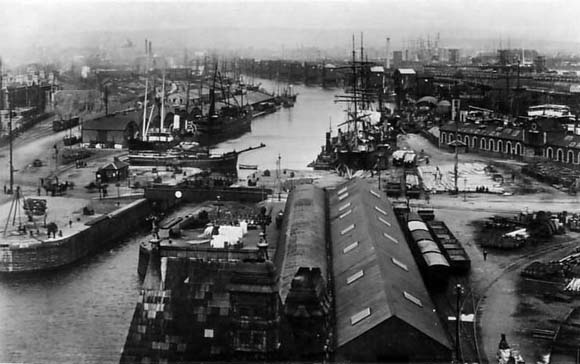|
Cardiff Docks
Cardiff Docks is a port in South Cardiff, Wales. At its peak, the port was one of the largest dock systems in the world with a total quayage of almost 11 km (6.8 mi). Once the main port for the export of South Wales coal, the Port of Cardiff remains active in the import and export of containers, steel, forest products and dry and liquid bulks.
History
Following the development of the coal found in the Cynon and Rhondda valley's and Merthyr area of South Wales, the export of both coal and iron products required a sea connection to the Bristol Channel if economic volumes of product were to be created.
In 1794, the Glamorganshire Canal was completed, linking the then small town of Cardiff with Merthyr, and in 1798 a basin was built, connecting the canal to the sea. By the 1830s, Cardiff became the pre-eminent iron-exporting port, shipping almost half of British overseas iron exports; between 1840 and 1870, the volume of coal exports increased from 44,350 to 2.219 million tonnes.
Bute Docks
Increasing agitation for proper dock facilities led Cardiff's foremost landowner, John Crichton-Stuart, 2nd Marquess of Bute, to promote the construction of the (West) Bute Dock, opened in October 1839. Just two years later, the Taff Vale Railway was opened, following much the same route as the canal.
With the construction of the new East Bute Dock from 1855, built by Thomas Cubitt's firm, its opening in 1859 resulted in coal supplanting iron as the industrial foundation of South Wales, with exports reaching 2 million tons as early as 1862.
Queen Alexandra Dock
Frustration at the lack of development at Cardiff led to rival docks being opened at Penarth in 1865 and Barry, Wales in 1889.
These developments eventually spurred Cardiff into action, with the opening of the Roath Dock in 1887, and the Queen Alexandra Dock in 1907. By then, coal exports from the South Wales Coalfield via Cardiff totalled nearly 9 million tons per annum, much of it exported in the holds of locally owned tramp steamers. By 1913, this had risen to 10,700,000 tons, making Cardiff the biggest coal exporting dock in the world.
Shipping
Cardiff's first steamship was the Llandaff of 1865, and by 1910, there were some 250 tramp steamers owned at Cardiff, by prominent firms such as William Cory & Son, Morel, Radcliffe, Tatem and Reardon-Smith. Each day, the principals of these companies would meet to arrange cargoes of coal for their ships in the opulent Coal Exchange in Mount Stuart Square. This trade reached its pinnacle in 1913, when 10.7 million tons of coal were exported from the port. After the First World War, there was a boom in shipping in Cardiff, with 122 shipping companies in existence in 1920. The boom proved short-lived, however; oil was growing in importance as a maritime fuel, and the terms of the Treaty of Versailles soon flooded Europe with cheap German reparation coal.
Railways
The Taff Vale Railway was built to transport coal from the South Wales Valleys to the docks. Its headquarters were a currently derelict building in Cardiff Bay railway station. The building was turned into a railway heritage centre in 1979 by the Butetown Historic Railway Society. By 1994 the Society had started to run steam locomotive hauled passenger services up and down 500 metres of track. However, as the Cardiff Bay Development Corporation had no interest in the railway, the Society changed its name to the Vale of Glamorgan Railway and moved from the site in 1997 to Barry Island railway station.
Decline
From 1910 onwards capacity issues meant that the more modern and less tidal Barry Docks took over as the largest volume export point of coal. Until the early 1920s, Cardiff docks continued to boom as a location for shipping companies, but the fall in demand for Welsh coal caused a dramatic fall in exports. By 1932, in the depths of the Great Depression which followed the General Strike in 1926, coal exports had fallen to below 5 million tonnes and dozens of locally owned ships were laid-up. Despite intense activity at the port during the Second World War and the attentions of the Nazi German Luftwaffe during the Cardiff Blitz, coal exports continued to decline, finally ceasing in 1964. In 1950, imports outstripped exports for the first time in the port's history. The 1970s saw a short-term import boom, and in the 1980s the port experienced a slight rise in traffic, while much of the former port area began to be regenerated into non-port uses. The port found a niche as an important local centre for general cargo operations.
Modern Port Facilities
Cardiff now has three operational docks capable of handling ships of up to 35,000 tons deadweight. The port has transit sheds with 258,500 m2 (2,782,000 sq ft) of storage space, two overland distribution sheds totalling 13,870 m2 (149,300 sq ft), and two timber sheds totalling 13,870 m2 (149,300 sq ft), two specialist steel sheds, with overhead gantry cranes, totalling 15,000 m2 (160,000 sq ft). There are 9 quayside cranes plus a range of mobile cranes. Cardiff's specialised facilities include a distribution terminal and chill and cold storage for perishables.
Tiger Bay
Tiger Bay was a local nickname for the general Cardiff Docks area, the evocative phrase deriving from the area's rough-and-tumble reputation. Merchant seamen arrived in Cardiff from all over the world, only staying for as long as it took to discharge and reload their ships: consequently many murders and lesser crimes went unsolved and unpunished, the perpetrators having sailed for other ports. In Victorian times, the name "Tiger Bay" was used in popular literature and slang (especially that of sailors) to denote any dock or seaside neighbourhood which shared a similar notoriety for danger.
|


